-
Pros
- Easy to carry out
- Intuitive
-
Cons
- Crude
- Only applies to on-balance sheet IR risk
- Looks at impact on income, not asset / liability values
- Results sensitive to choice of horizon
PV01 Analysis
-
Also applies to fixed income positions
-
Addresses what will happen to bond price if interest rises by 1 basis point
-
Price bond at current interest rates
-
Price bond assuming rate rise by 1 bp
-
Calculate loss as current minus prospective bond prices
Duration Analysis
-
Another traditional approach to IR risk assessment
-
Duration
- weights are present values of each cashflow, divided by PV of all cashflows
-
Duration indicates sensitivity of bond price to change in yield:
-
Can approximate duration using simple algorithm as
-
Duration is a linear function: duration of porfolio is sum of durations of bonds in portfolio
-
Duration assumes
-
Duration ignores embedded options
-
Duration analysis supposes that yield curve shifts in parallel
Convexity
-
If duration takes a
-
Convexity is the second order term in a Taylor series approximation
- Convexity is defined as
-
Convexity term gives a refinement to the basic duration approximation
-
In practice, convexity adjustment often small
-
Convexity a valuable property
-
Makes losses smaller, gains bigger
-
Can approximate convexity as
Pros and cons of duration-convexity
-
Pros
- Easy to calculate
- Intuitive
- Looks at values, not income
-
Cons
- Crude (only first-order approx, problems with non-parallel moves in spot rate curve, etc.)
- Often inaccurate even with refinements (e.g., convexity)
- Applies only to IR risks
Scenario Analysis
-
'What if' analysis – set out scenarios and work out what we gain/lose
-
Select a set of scenarios, postulate cashflows under each scenario, use results to come to a view about exposure
-
SA not easy to carry out
- Much hinges on good choice of scenario
- Need to ensure that scenarios do not involve contradictory or implausible assumptions
- Need to think about interrelationships involved
- Want to ensure that all important scenarios covered
-
SA tells us nothing about probabilities
- Need to use judgement to determine significance of results
-
SA very subjective
-
Much depends on skill and intuition of analyst
Portfolio Theory
-
Starts from premise that investors choose between expected return and risk
- Risk measured by std of portfolio return
-
Wants high expected return and low risk
-
Investor chooses portfolio based on strength of preferences for expected return and risk
- Investor determines efficient portfolios, and chooses the one that best fits preferences
-
Investor who is highly (slightly) risk averse will choose safe (risky) portfolio
-
Key insight is that risk of any position is not its std, but the extent to which it contributes to portfolio std
- Asset might have a high std, but contribute small risk, and vice versa
-
Risk is measured by beta (why?) – which depends on correlation of asset return with portfolio return
-
High beta implies high correlation and high risk
-
Low beta implies low correlation and low risk
-
Zero beta implies no risk
-
Ideally, looking for positions with negative beta
- These reduce portfolio risk
-
PT widely used by portfolio managers
-
But runs into implementation problems
- Estimation of beta highly problematic
- Each beta is specific to data and portfolio
- Need a long data set to get reliable result
-
Practitioners often try to avoid some of these problems by working with `the' beta (as in CAPM)
- But this often requires CAPM assumptions to hold
- One market risk factor, etc.
-
CAPM discredited (Fama-French, etc.)
Derivatives risk measures
-
Can measure risks of derivatives positions by their Greeks
- Delta
- Gamma
- Rho
- Theta
- Vega
- Delta
-
Use of Greeks requires considerable skill
-
Need to handle different signals at the same time
-
Risks measures only incremental
- Work against small changes in exogenous factors
- Can be Greek-hedged, but still be very exposed if there are large exogenous shifts
- Hedging strategies require liquid markets, and can fail if market liquidity dries up (as in Oct 1987)
-
Risk measures are dynamic
- Can change considerably over time
- E.g., gamma of ATM option goes to infinity
Value at Risk (VaR)
Value at Risk
-
In late 1970s and 1980s, major financial institutions started work on internal models to measure and aggregate risks across institution
-
As firms became more complex, it was becoming more difficult but also more important to get a view of firmwide risks
-
Firms lacked the methodology to do so
- Can't simply aggregate risks from sub-firm level
RiskMetrics
- Bestknown system is RiskMetrics developed by JP Morgan
- Supposedly developed by JPM staff to provide a `4:15' report to CEO, Dennis Weatherstone.
- What is maximum likely trading loss over next day, over whole firm?
- To develop this system, JPM used portfolio theory, but implementation issues were very difficult
-
Staff had to
- Choose measurement conventions
- Construct data sets
- Agree statistical assumptions
- Agree procedures to estimate volatilities and correlations
- Set up computer systems for estimation, etc.
-
Main elements of system working by around 1990
-
Then decided to use the '4:15' report
- A one-day, one-page summary of the bank's market risk to be delivered to the CEO in the late afternoon (hence the ''4:15'')
-
Found that it worked well
-
Sensitised senior management to risk-expected return tradeoffs, etc.
-
New system publicly launched in 1993 and attracted a lot of interest
-
Other firms working on their systems
- Some based on historical simulation, Monte Carlo simulation, etc.
-
JPM decided to make a lower-grade version of its system publicly available
-
This was RiskMetrics system launched in Oct 1994
- Stimulated healthy debate on pros/cons of RiskMetrics, VaR, etc.
-
Subsequent development of other VaR systems, applications to credit, liquidity, op risks, etc.
Portfolio theory and VaR
-
PT interprets risk as std of portfolio return, VaR interprets it as maximum likely loss
- VaR notion of risk more intuitive
-
PT assumes returns are normal or near normal, whilst VaR systems can accommodate wider range of distributions
-
VaR approaches can be applied to a wider range of problems
- PT has difficulty applying to non-market risks, whereas VaR applies more easily to them
-
VaR systems not all based on portfolio theory
- Variance covariance systems are; others are not
Attractions of VaR
-
VaR provides a single summary measure of possible portfolio losses
-
VaR provides a common consistent measure of risk across different positions and risk factors
-
VaR takes account of correlations between risk factors
Uses of VaR
-
Can be used to set overall firm risk target
-
Can use it to determine capital allocation
-
Can provide a more consistent, integrated treatment of different risks
-
Can be useful for reporting and disclosing
-
Can be used to guide investment, hedging, trading and risk management decisions
-
Can be used for remuneration purposes
-
Can be applied to credit, liquidity and op risks
Criticisms of VaR
-
VaR was warmly embraced by most practitioners, but not by all
-
Concern with the statistical and other assumptions underlying VaR models
- Hoppe and Taleb
-
Concern with imprecision of VaR estimates
- Beder
-
Concern with implementation risk
- Marshall and Siegel
-
Concern with risk endogeneity
- Traders might ‘game’ VaR systems
- Write deep out-of-the-money options
-
Uses of VaR as a regulatory constraint might destabilise financial system or obstruct good practice
-
Concern that VaR might not be best risk measure
- Limits of VaR, development of coherent risk measures
Advanced Risk Models: Univariate
Value-at-Risk (VaR)
- VaR is the maximum loss over a target horizon such that there is a low, prespecified probability that actual loss will be larger.
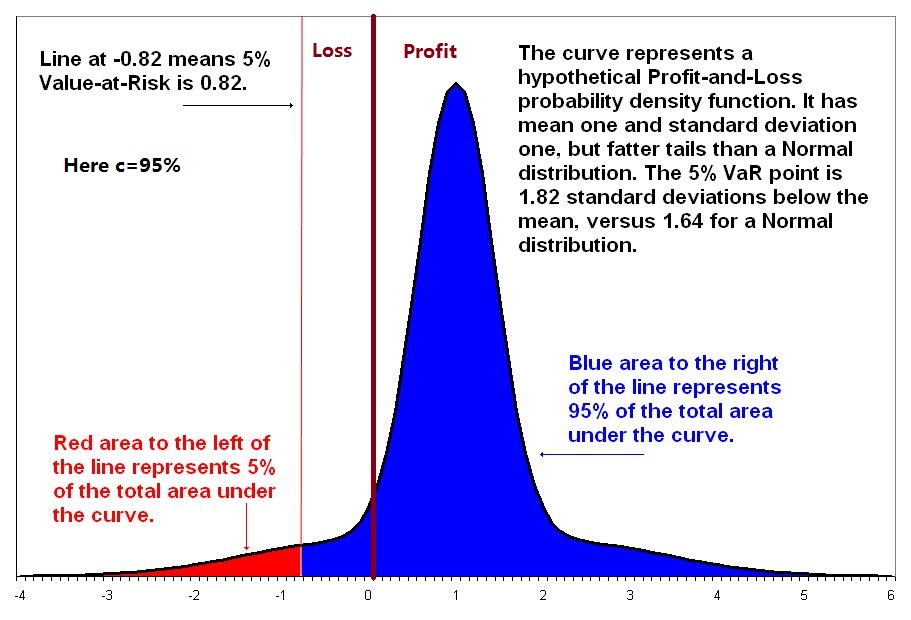
- Formula
or,
VaR Parameters: The Confidence Level (cl)

- VaR rises with confidence level (cl) at an increasing rate
VaR Parameters: The Holding Period (hp)
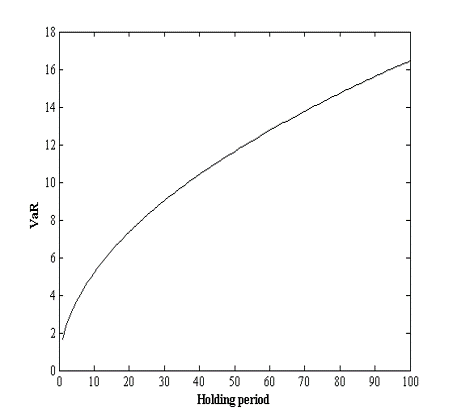
- If mean is zero, VaR rises with square root of holding period
- 'Square root rule':
- Daily innovations must be i.i.d. standard normal (why?)
- Empirical plausibility of SRR very doubtful (why?)
VaR Surface
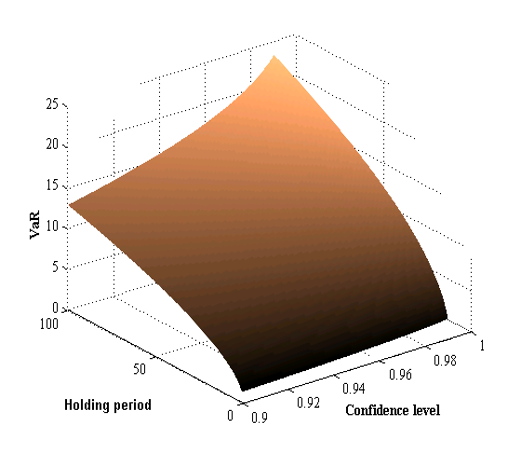
- VaR surface is much more revealing
- A single VaR number is just a point on the surface – doesn’t tell much
- With zero mean, get spike at high cl and high hp
Determine the Confidence Level
-
High cl if we want to use VaR to set capital requirements
- E.g., 99% under Basel
-
Lower if we want to use VaR
- to set position limits
- for reporting/disclosure
- for backtesting (we will discuss it later)
Determine the Holding Period
-
Depends on investment/reporting horizons
-
Daily common for cap market institutions
-
10 days (or 2 weeks) for banks under Basel
-
Can depend on liquidity of market – hp should be equal to liquidation period
-
Short hp makes it easier to justify assumption of unchanging portfolio
-
Short hp preferable for model validation/backtesting requirements
- Short hp means more data to use
Limitation of VaR
-
VaR estimates subject to error
-
VaR models subject to (considerable!) model risk
- Beder
-
VaR systems subject to implementation risk
- Marshal and Siegel
-
But these problems common to all risk measurement systems
VaR uninformative of tail losses
-
VaR tells us most we can lose at a certain probability, i.e., if tail event does not occur
-
VaR does not tell us anything about what might happen if tail event does occur
-
Trader can spike firm by selling out of the money options
- Usually makes a small profit, occasionally a very large loss
- If prob of loss low enough, such a position appears to have no risk, but can be very dangerous
-
Two positions with equal VaRs not necessarily equally risky, because tail events might be very different
-
Solution to use more VaR information – estimate VaR at higher cl
VaR creates perverse incentives
-
VaR-based decision calculus can be misleading, because it ignores low-prob, high-impact events
- Events with probs less than VaR tail prob ignored
-
Additional problems if VaR is used in a decentralized system
-
VaR-constrained traders/managers have incentives to 'game' the VaR constraint
- Sell out of the money options, etc.
VaR can discourage diversification
-
VaR of diversified portfolio can be larger than VaR of undiversified one
-
Example
- 100 possible states, 100 assets, each making a profit in 99 (different) states, and a high loss in one
- Diversified portfolio is certain to experience a high loss
- Undiversified portfolio is not
- Hence, VaR of diversified portfolio higher than VaR of undiversified one
VaR not subadditive
- A risk measure
-
Aggregating individual risks does not increase overall risk
-
Important because: Adding risks together gives conservative (over-) estimate of portfolio risk – want bias to be conservative
-
If risks not subadditive and VaR used to measure risk
- Firms tempted to break themselves up to release capital
- Traders on organized exchanges tempted to break up accounts
- In both cases, problem of residual risk exposure
-
Subadditivity is highly desirable
-
But VaR is only subadditive if risks are normal or elliptical
-
VaR not subadditive for arbitrary distributions
Coherent Measure of Risk
Coherent Risk Measures
-
Let
- Monotonicity: if
- Translation invariance:
- Homogeneity:
- Subadditivity:
- Monotonicity: if
-
Homogeneity and Monotonicity imply convexity, which is important
-
Translation invariance means that adding a sure amount to our end-period portfolio will reduce loss by amount added
Implications of coherence
-
Any coherent risk measure is the maximum loss on a set of generalized scenarios
- GS is set of loss values and associated probs
-
Maximum loss from a subset of scenarios is coherent
-
Outcomes of stress tests are coherent
- Coherence theory provides a theoretical justification for stress testing!
-
Coherence risk measures can be mapped to user’s risk preferences
-
Each coherent measure has a weighting function
-
-
Can choose a coherent measure to suit risk preferences
Alternative Measures of Risk: CVaR
- The Conditional VaR (CVaR) is the expected loss, given a loss exceeding VaR
-
it is also called expected shortfall, tailed conditioal expectation, conditional loss, or expected tail loss
-
VaR tells us the most we can lose if a tail event does not occur, CVaR tells us the amount we expect to lose if a tail event does occur
-
CVaR is coherent
CVaR is better than VaR
-
Tell us what to expect in bad states
- VaR tells us nothing
-
CVaR-based decision rule valid under more general conditions than a VaR-based one
- CVaR rule valid under second-order stochastic dominance
- VaR rule valid under first-order stochastic dominance
- FOSD more stringent than SOSD
-
CVaR coherent, and therefore always subadditive
-
CVaR does not discourage risk diversification, VaR sometimes does
-
CVaR-based risk surface always convex
- Convexity ensures that portfolio optimization has a unique well-behaved optimum
- Convexity also enables problems to be solved easily using linear programming methods
Alternative Measures of Risk: Worst-case scenario analysis
-
This is the outcome of a worst-case scenario analysis (Boudoukh et al)
-
Can consider as high percentile of distribution of losses exceeding VaR
- Whereas CVaR is expected value of this distribution
-
WCSA is also coherent, produces risk measures bigger than CVaR
Alternative Measures of Risk: SPAN
-
Standard-Portfolio Analysis Risk (SPAN, CME)
-
Considers 14 scenarios (moderate/large changes in vol, changes in price) + 2 extreme scenarios
-
Positions revalued under each scenario, and the risk measure is the maximum loss under the first 14 scenarios plus 35% of the loss under the two extreme scenarios
-
SPAN risk measure can be interpreted as maximum of expected loss under each of 16 probability measures, and is therefore coherent
Alternative Measures of Risk: Other Methods
- The Semistandard Deviation
- The Drawdown
-
Try to verify wether the following popular risk measures are coherent measures of risk or not
- Standard deviation
- VaR
- CVaR
- WCSA
- SPAN
Stress-Testing
What are stress tests?
-
STs are procedures that gauge vulnerability to 'what if' events
- Used for a long time, especially to gauge institutions IR exposure
-
Early stress tests 'back of envelope' exercises
-
Major improvements in recent years, helped by developments in computer power
-
Modern ST much more sophisticated than predecessors
Modern stress testing
-
ST received a major boost after 1998
-
Realisation that it would have helped firms to protect themselves better in '98 crisis'
-
ST very good for quantifying possible losses in non-normal situations
- Breakdowns in normal correlation relationships
- Sudden decreases in market liquidity
- Handling concentration risks
- Handling macroeconomic risks
-
STs versus probabilistic aprpoaches
- STs are a natural complement to probabilistic approaches
- VaR and CVaR good on prob side, but poor on 'what if'
- STs poor on prob side, but good on 'what if'
- STs not designed to answer prob questions
Categories of STs
- Different types of event (normal, extreme, etc.)
- Different types of risk (market, credit, etc.) and risk factors (equity risks, yield curve, etc.)
- Different country/region factors
- Different methodologies (scenario analysis, factor push, etc.)
- Different assumptions (relating to yields, stock markets, etc.)
- Different books (trading, banking)
- Differences in level of test (firmwide, business unit, etc.)
- Different instruments (equities, futures, options, etc.)
- Differences in complexity of portfolio
Main types of stress test
-
Scenario ('what if') analysis
- Analyse impact of specific scenario on our financial position
-
Mechanical stress tests
- Evaluate a number of math/stat defined scenarios (e.g., defined in terms of movements in underlying risk factors)
- Work through these in a mechanical way
Uses of stress tests
-
Can provide good risk information
- Good for communicating risk information
- Results from STs readily understandable
- But must avoid swamping recipients with too much data
-
Can guide decision making
- Allocation of capital, setting of limits, etc.
-
ST can help firms to design systems to deal with bad events
- Can check on modelling assumptions, contingency planning, etc.
Benefits of stress testing
-
Good for showing hidden vulnerability
-
Can improve on VaR type information in various ways
- Since stress events unlikely, VaR systems unlikely to reveal much about them
- Short VaR holding period will often be too short to reveal full impact of stress event
- Stress tests better at handling non-linearities that arise in stress situations
- Stress test can take account of unusual features in a stress scenario
-
Can more easily identify a firm’s breaking point
- Identify lethal conjunctions of events, etc.
-
Can give a clearer view about dangerous scenarios
- This helps in deciding they might be handled
-
Stress tests particularly good for identifying and handling liquidity exposures
- Loss of liquidity a key feature of crises
-
Stress tests also very good for handling large market moves
- Market crashes, etc
-
Stress tests good for handling possible changes in market volatility
- Help identify possible risks in overall risk exposure, gains/losses on derivatives positions, etc
-
Stress tests for good for handling exposure to correlation changes
- These very significant in major crises
-
Stress tests good for highlighting hidden weaknesses in risk management system
- Identify hidden 'hot spots' in portfolio
Difficulties with STs
-
Much less straightforward than it looks
-
Based on large numbers of decisions about
- choice of scenarios and risk factors
- how risk factors should be combined
- Ranges of values to be considered
- Choice of time horizon, etc.
-
ST results completely dependent on chosen scenarios and how they are modelled
- When portfolios are complex, can be very difficult even to identify the risk factors to look at
-
Difficulty of working through scenarios in a consistent way
-
Need to follow through scenarios, and consequences can be very complex and can easily become unmanageable
-
Need to take account of interrelationships in a reasonable way
- Need to account for correlations
-
Need to take account of zero arbitrage relationships
- Eliminate 'impossible' events?
-
ST & Prob Analysis
-
Interpretation of ST results
-
STs do not address prob issues as such
-
Hence, always an issue of how to interpret results
-
This implies some informal notion of likelihood
- If prob is negligible, result of ST might have little bearing
- If prob is significant, result might be importan
-
-
Integrating ST and prob analysis
-
Can integrate ST and prob analysis using Berkowitz’s coherent framework
- Do prob analysis – VaRs at different cls
- Do ST analysis
- Assign probs to ST scenarios
- Integrate these outcomes into prob analysis
-
This approach is judgemental, but does give an integrated analysis of both probs and STs
-
Choosing scenarios
-
moving key variables one at a time
-
using historical scenarios
-
creating prospective scenarios
-
reverse stress tests
Stylised Scenarios
-
Simulated movement in major IRs, stock prices, etc.
- Can be expressed in absolute changes or multiple-of-std changes
-
Long been used in ALM analysis
-
Problem is to keep scenarios down in number, without missing plausible important ones
Actual Historical Scenarios
-
Based on actual historical events
-
Advantages
- They have plausibility because they have occurred
- Readily understood
-
Can choose scenarios from a catalogue, which might include
-
Moderate market changes
-
More extreme events such as reruns of major crashes
- A good guide is to choose scenarios that are of same order of magnitude as worst-case events in our data sets
-
Hypothetical One-Off Events
-
These might be natural, political, legal, major defaults, counterparty defaults, economic crises, etc.
-
Can obtain them by alternate history exercises
- Rerun historical scenarios and ask what might have been
-
Can also look to historical record to guide us in working out what such scenarios might look like
Evaluating scenarios
-
Having specified our set of scenarios, we then need to evaluate their effects
-
Key is to get an understanding of the sensitivities of our positions to changes in the risk factors being changed
-
Easy for some positions
- E.g., linear FX, stock, futures positions
-
Harder for options
- Must account for (changing) sensitivities to underlying
- Might need approximations, e.g., delta-gamma
-
Must pay particular attention to impact of stylised events on markets
-
Very unwise to assume that liquidity will remain strong in a crisis
-
If futures contracts are used hedges, must also take account of funding implications
-
Otherwise well-hedged positions can unravel because of interim funding
Mechanical ST
-
These approaches try to reduce subjectivity of SA and put ST on firmer foundation
- Instead of using subjective scenarios, we use math/stat generated scenarios
- Work through these in a systematic way
- Work out most damaging conjunctions of events
-
Mechanical ST more systematic and thorough than SA, but also more intensive
Factor Push Analysis
-
Push each price or factor by a certain amount
- Better to push factors than prices, due to varying sensitivities of prices to factors
-
Specify confidence level
-
Push factors up/down by
-
Revalue positions each time,
-
Work out most disadvantageous combination
-
This gives us worst-case maximum loss (ML)
-
FP is easy to program, at least for simple positions
-
Does not require very restrictive assumptions
-
Can be modified for correlations,
-
Results of FP are coherent
-
If we are prepared to make further assumptions, FP can also give us an indication of likelihoods
- ML estimates tend to be conservative estimates of VaR
- Can adjust the
-
But FP rests on assumption that highest losses occur when factors move most, and this is not true for some positions
Maximum Loss Optimisation
-
Solution to this problem is to search over interim values of factor ranges
-
This is MLO
-
MLO is more intensive, but will pick up high losses that occur within factor ranges
- E.g., as with losses on straddles
-
MLO is better for more complex positions, where it will uncover losses that FP might miss
Backtesting
Backtesting
-
Backtesting is the process to compare systematically the VaR forecasts with actual returns.
- It should detect weaknesses in the models and point to areas for improvement
- It is one of the reasons that bank regulators allow banks to use their own risk measures to determine the amount of regulatory capital
-
Backtesting compares the daily VaR forecast with the realized profit and loss (P&L) the next day.
- It is recorded as an exception if the actual loss is worse than the VaR
- The risk manager counts the number if exceptions
-
Trading outcome
- Actual portfolio
- Hypothetical portfolio (no intraday trading, no fee income)
- The Basel framework recommends using both hypothestical and actual trading outcomes in backtests
Preparing Data: Obtaining Data
-
Need to obtain suitable P/L data
-
Accounting (e.g., GAAP) data often inappropriate because of smoothing, prudence etc
-
Want P/L data that reflect market risks taken
- Need to eliminate fee income, bid-ask profits, P/L from other risks taken (e.g., credit risks), unrealised P/L, provisions against future losses
-
Need to clean data or use hypothetical P/L data (obtained by revaluing periods from day to day)
Preparing Data: Draw up backtest chart

- Good to plot P/L data against risk bounds over time
- Chart good indicator of possible problems
- over-estimation of risks
- under-estimation of risks
- bias
- excessive smoothness in risk bounds, etc.
Preparing Data: Get to know data
-
Draw up summary statistics
- Mean, std, skewness, kutosis, min, max, etc.
-
Draw up QQ charts
- Plots of predicted vs. empirical quantiles
-
Draw up charts of predicted vs. empirical probs
-
Shape of these curves indicates whether supposed pdf fits the data – very useful diagnostic
Preparing Data: Standardise Data
-
P/L data typically random
-
Porfolios and dfs often change from day to day
-
How to compare P/L data if underlying pdfs change?
-
Good practice to map P/L data to predicted percentile
- If observation falls 90% percentile of predicted P/L distribution, then mapped value is 0.90
-
This standardizes data to make observations comparable given changes in pdf or porfolio
Measuring Exceptions
-
Binomial Distribution
- Probability mass function
- Mean:
- Example: For instance, we want to know what is the probability of observing
So, we would expect to observe 8.1% of samples with zero exceptions under the null hypothesis. We can repeat this calculation with different values for
- Normal Approximation
-
Decision Rule for Backtests
- Type 1 errors: kill the good guy
- Type 2 errors: miss the bad guy
- Power of a test is one minus the type 2 error rate
- Most statistical tests fix the type 1 error rate, say at 5%, and structure the test so as to minimize the type 2 error rate, or maximize the test's power
Example
Consider a VaR measure over a daily horizon defined at the 99% level of confidence

- A higher cutoff point would lower the type 1 error rate
- It is more likely to miss VaR models that are misspecified with higher cutoff points
Basel Rule for Backtests
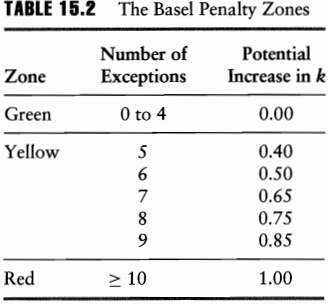
- The normal multiplier
- After an incursion into the yellow zone
- An incursion into the red zone generates an automatic, non-discretionary penalty

Evaluation of Backtesting
-
Exception tests focus only on the frequency of occurrences
-
It ignores the time pattern of losses
Advanced Risk Models: Multivariate
The Big Idea
Components of a Multivariate Risk Modeling Systems
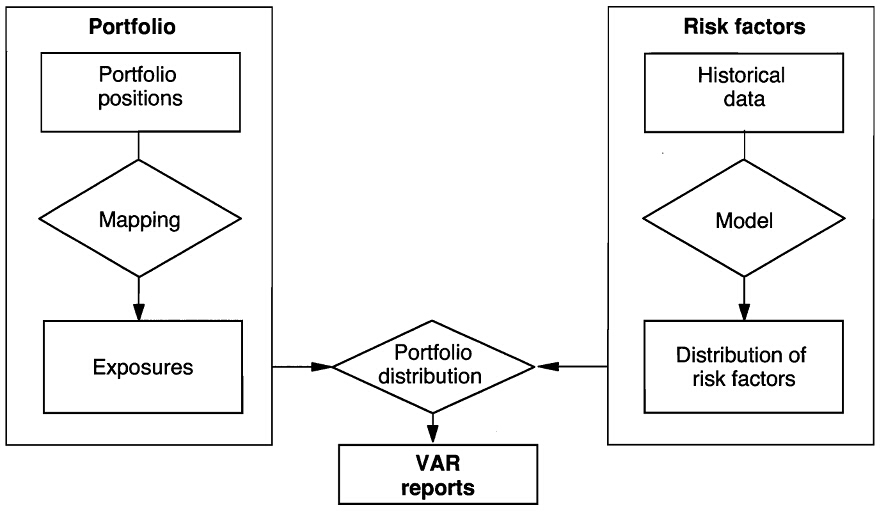
-
Risk system
- portofolio position system
- risk factor modeling system
- aggregation system
-
Describe joint movements in the risk factors
- specify an analytical distribution
- take the joint distribution from empirical observations
-
Aggregation: VaR methods
- delta-normal method
- historical simulation method
- Monte Carlo simulation method
Risk Mapping
Introduction
-
Have assumed so far that each position has its own risk factor, which we model directly
- Distinguish between positions and risk factors
-
However, it is not always possible or desirable to model each position as having its own risk factor
-
Might wish to map our positions onto some smaller set of risk factors
- Might wish to map
- Might wish to map
Reasons for mapping
-
Might not have enough data on our positions
- E.g., might have small runs of Emerging Market data
- Map to risk factors for which we do have data
-
Might wish to cut down on the dimensionality of our covariance matrices
- This is important!
- With
- As
-
Need to keep dimensionality down to avoid computational problems too – rank problems, etc.
Stages of mapping
-
Construct a set of benchmark instruments or factors
- Might include key bonds, equities, etc.
-
Collect data on their volatilities and correlations
-
Derive synthetic substitutes for our positions, in terms of these benchmarks
- This substitution is the actual mapping
-
Construct VaR/CVaR of mapped porfolio
-
Take this as a measure of the VaR/CVaR of actual portfolio
Selecting Core Instruments
-
Usual approach to select key core instruments
- Key equity indices, key zero bonds, key currencies, etc.
-
Want to have a rich enough set of these proxies, but don’t want so many that we run into covariance matrix problems
-
RiskMetrics core instruments
- Equity positions represented by equivalent amounts in key equity indices
- Fixed income positions by represented by combinations of cashflows of a limited number of maturities
- FX positions represented by relevant amounts in `core' currenicies
- Commodity positions represented by amounts of selected standardised futures positions
Mapping with Principal Components
-
Can use PCA to identify key factors
-
Small number of PCs will explain most movement in our data set
-
PCA can cut down dramatically on dimensionality of our problem, and cut down on number of covariance terms
- E.g., with 50 original variables, have
- With 3 PCs, have only 3 separate covariance terms
- E.g., with 50 original variables, have
Mapping Positions to Risk Factors
-
Most positions can be decomposed into primitive building blocks
-
Instead of trying to map each type of position, we can map in terms of portfolios of building blocks
-
Building blocks are
- Basic FX
- Basic equity
- Basic fixed-income
- Basic commodity
A General Example of Risk Mapping

- Replace each if the
- Aggregate the
- Derive the distribution of the portfolio return
Example: Mapping with Factor Models
-
Decompose stock return
- a constant term (not important fot risk management purpose)
- a component due to the market
- a residual term
-
The portfolio return
- Mean:
- Variance:
- For equally weighted portfolio:
- The mapping:
- Mean:
-
This approach is useful especially when there is no return history
Example: Mapping with Fixed-Income Portfolios
-
Risk-free bond portfolio
-
maturity mapping: replace the current value of each bond by a position on a risk factor with the same maturity
-
duration mapping: maps the bond on a zero-coupon risk factor with a maturity equal to the duration of the bond
-
cash flow mapping: maps the current value of each bond payment on a zero-coupon risk factor with maturity equal to the time to wait for each cash flow
-
Corporate bond portfolio
- Decomposition:

- the movement in the value of bond price
- the portfolio:
- aggregation:
- Variance:
Choice of Risk Factors
It should be driven by the nature of the portfolio:
-
portfolio of stocks that have many small positions well dispersed across sectors
-
portfolios with a small number of stocks concentrated in one sector
-
an equity market-neutral portfolio
-
Mapping Complex Positions
- Complex positions are handled by apply financial engineering theory
- Reverse-engineer complex positions into portfolios of simple positions
- Map complex positions in terms of collections of synthetic simple positions
- Some examples, using FE/FI theory:
- Coupon-paying bonds: can regard as portfolios of zeros
- FRAs: equivalent to spreads in zeros of different maturities
- FRNs: equivalent to a zero with maturity equal to period to next coupon payment (because it reprices at par)
- Vanilla IR swaps: equivalent to portfolio long a fixed-coupon bond and short a FRN
- Structured notes: equivalent to combinations of IR swaps and conventional FRNs
- FX forwards: equivalent to spread between foreign currency bond and domestic currency bond
- Commodity, equity and FX swaps: combinations of spread between forward/futures and bond position
Dealing with Optionality
-
All these positions can be mapped with linear based mapping systems because of their being (close to) linear
-
These approaches not so good with optionality
- Non-linearity of options positions can lead to major errors in mapping
-
With non-linearity, need to resort to more sophisticated methods, e.g., delta-gamma and duration-convexity
Joint Distribution of Risk Factors
-
Copula is a function of the values of the marginal distributions
-
Sklar's theorem: For any joint density there exists a copula that links the marginal densities:
-
This result enables us to construct joint density functions from the marginal density functions and the copula function
-
Takes account of dependence structure
-
To model joint density function, specify marginals, choose copula, and then apply copula function
Common Copulas
-
Independence (product) copula$ = uv$
- Good for independent random variables
-
Minimum copula
- Good for comonotonic variables
-
Maximum copula
- Good for countermonotonic variables
-
Gaussian copulas
- For multi-variable normality, does not have closed form copula functions
-
t-copulas
- For multi-variable
- For multi-variable
-
Gumbel copulas, Archimedean copulas
-
Extreme value copulas
- Arising from EVT
Tail Dependence
- Upper & lower conditional probabilities
-
When
-
Gives an idea of how one variable behaves in limit, given high value of another
Extreme Value Theory
Peaks Over Threshold Approach & the GP Distribution
The limit distribution for values
-
It is called the generalized Pareto (GP) distribution
- EVT distribution is only asymptotically valid (i.e., as
-
It subsumes other distributions as special cases
Block Maxima vs. Peaks over Threshold

- Block maxima approach: group the sample into successive blocks, from which each maximum is identified.
- Generalized extreme value (GEV) distribution
EVT vs. Normal Densities
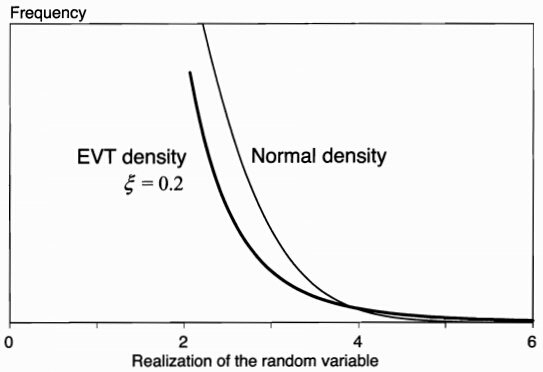
VaR and EVT
Close-form solutions for VaR and CVaR rely heavily on the estimation of
-
Maximum likelihood
- define a cutoff point
- only consider losses beyond
- define a cutoff point
-
Method of moments
- fitting the parameters so that the GP moments equal the observed moments
-
Hill's estimator
- sort all observations from highest to lowest
- tail index is estimated from
- no theory tells how to choose
- we may plot
Problems with EVT
-
Estimates are sensitive to changes in the sample
-
Results depend on assumptions and estimation method
-
It relies on historical data
VaR Methods
Delta-Normal
-
Assumption
- portfolio exposures are linear
- risk factors are jointly normally distributed
-
The VaR
- portfolio return is normally distributed
- the portfolio variance:
- VaR is directly obtained from the standard normal deviate
- diversified VaR vs. undiversified VaR
-
Advantages & Drawbacks
- advantages: simple, closed-form, more precise, less sampling variability
- drawbacks: can not account for nonlinear effects (option), underestimate the occurrence of large observations (normal assumption)
Historical Simulation
- The Idea: replays a ''tape'' of history to current positions
- go back in time (e.g. over the past 250 days)
- project hypothetical factor values using the factor movements
- derive the portfolio values
- The VaR
- current portfolio value as function of current risk factors:
- sampling factor movements from the historical distribution:
- construct hypothetical factor values:
- current portfolio value:
- portfolio return:
- VaR is obtained from the difference between the average and the c-th quantile:
- current portfolio value as function of current risk factors:
- Advantages & Drawbacks
- advantages: no specific distributional assumption, intuitive
- drawbacks: its reliance on a short historical moving window to infer movements in market prices
Monte Carlo Simulation
-
The Idea
- is similar to the historical simulation method
- the movements in risk factors are generated from a prespecified distribution:
- the risk manager needs to specify the marginal distribution of risk factors as well as their copula
-
Advantages & Drawbacks
- advantages: most flexible
- drawbacks: computational burden, subject to model risk, sampling variability
-
It should converge to the delta-normal VaR if all risk factors are normal and exposures are linear
Comparison of Methods

Limitations of Risk Systems
Limitations of Risk Systems
-
Illiquid Assets
-
Losses Beyond VaR
-
Issues with Mapping
-
Reliance on Recent Historical Data
-
Procyclicality
-
Crowded Trades
课堂练习
A、B两只股票最近30周的周回报率如下所示(单位:1%):
A: -3,2,4,5,0,1,17,-13,18,5,10,-9,-2,1,5,-9,6,-6,3,7,5,10,10,-2,4,-4,-7,9,3,2;
B: 4,3,3,5,4,2,-1,0,5,-3,1,-4,5,4,2,1,-6,3,-5,-5,2,-1,3,4,4,-1,3,2,4,3。
某金融机构用A、B按1:1比例构造投资组合。
(a) 请分别计算组合在90%置信水平下的VaR和CVaR。
(b) 通过计算验证VaR和CVaR是否为相容风险度量(coherent measure of risk)。
课堂练习
某交易组合是由价值300,000美元的黄金投资和价值500,000美元的白银投资构成,假定以上两资产的日波动率分别为1.8%和1.2%,并且两资产回报的相关系数为0.6,请问:(
(a) 交易组合10天展望期的97.5%VaR为多少?
(b) 投资分散效应减少的VaR为多少?
课堂练习
假设我们采用100天的数据来对VaR进行回溯测试,VaR所采用的置信水平为99%,在100天的数据中我们观察到5次例外。如果我们因此而拒绝该VaR模型,犯第一类错误的概率为多少?